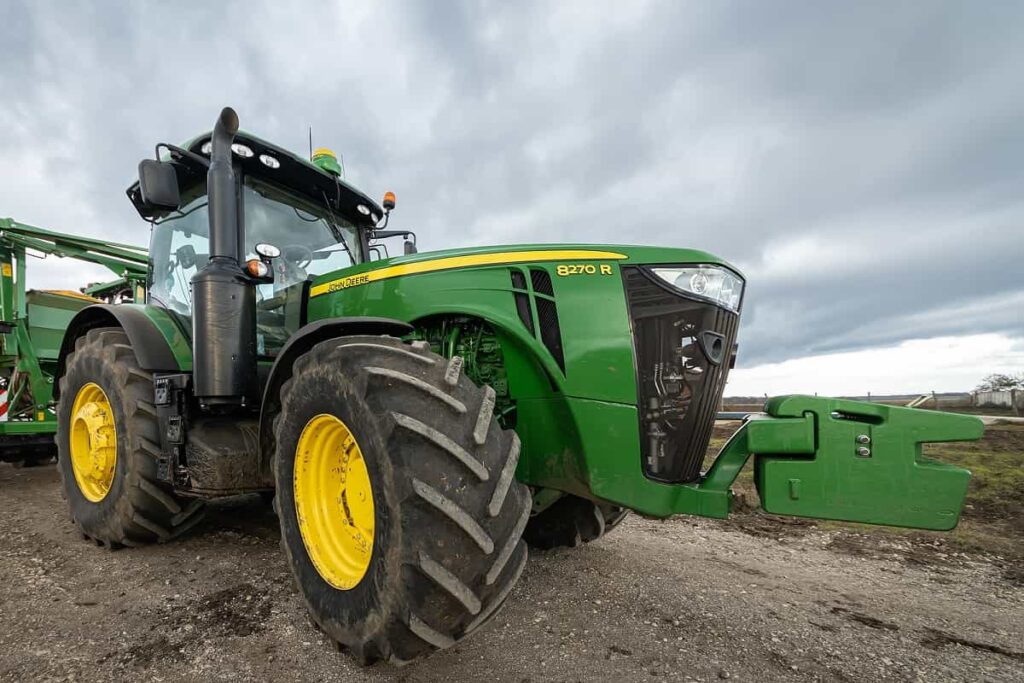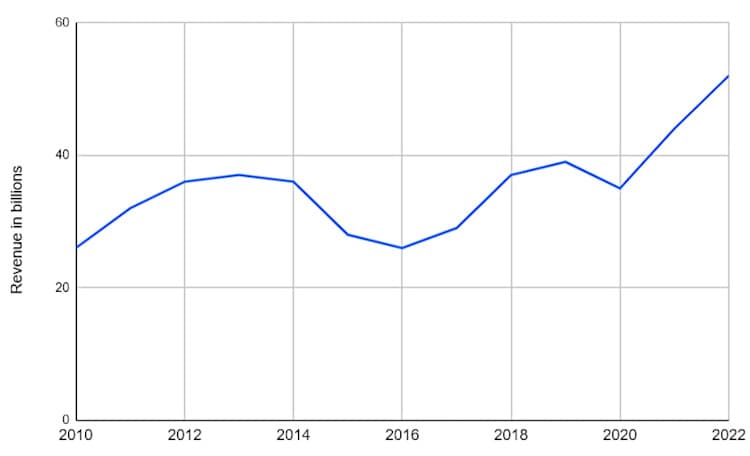Is John Deere Stock a Good AgTech Play?

Last month, we took a deep dive into the market opportunities surrounding heavy equipment based on the emergence of three kinds of technologies for driving new revenue growth. The article focused on automation, digitization (IoT and digital twins), and electrification. We calculated there is at least a total addressable market (TAM) of $56 billion for automating, digitizing, and connecting the operation of heavy equipment. As the leading construction equipment manufacturer, Caterpillar (CAT) seemed like a potentially good play on investing in high-tech heavy equipment. After all, it has already developed about 600 robotic mining trucks.
But as we started to scratch below the surface of Caterpillar’s technological transformation, we were not finding much in SEC filings, transcripts, and news stories to offer much additional color to the story. We’re not saying that Caterpillar is not trending in this direction, but maybe it is moving at the speed of a crane in high winds. Recent acquisitions and investments suggest the company is more focused on the electrification part of the equation – a trend with more ambiguous payoffs at this juncture. For example, Caterpillar participated in a $1 billion Series D last month for Redwood Materials, a battery recycling startup, and a Seed round earlier this year for an electrical engineering firm called Lithos Energy that specializes in lithium-ion tech.
John Deere Stock Plowing Ahead

During our research, the name of another heavy equipment manufacturer emerged – John Deere (DE). Yup, the 185-year-old maker of tractors and other farm equipment, an industry that the average city slicker might assume has not evolved much since the 18th-century invention of the cotton gin (and, no, that has nothing to do with a farm-to-table cocktail). But Big Ag is big business these days: John Deere is a $110 billion company with more than $60 billion in annualized revenues. The company has basically doubled revenues since 2016, following several years of declining revenues and despite a roughly $4 billion drop in annual revenue during the 2020 pandemic year.

A five-year snapshot shows that John Deere stock has gained more than +150%. That’s pretty much double the gain for Caterpillar during the same time period. Invesco QQQ ETF, which follows the top 100 companies on the tech-heavy Nasdaq, only gained +90% over the last five years. What put John Deere on this new trajectory?
It’s going to sound a bit cliché, but certainly one factor is technological innovation. In this article, we’re going to look at how the company is positioning itself to become a pure-play AgTech stock by broadly commercializing advances in connectivity, digitization, and automation. And, of course, we’ll debate whether that’s enough to justify a long-term investment into John Deere stock.
A Brief History of John Deere and AgTech
One could argue that the farm equipment manufacturer was a pioneer in AgTech dating back to 1837 when its founder, John Deere, developed a steel plow. But we’re going to jump ahead to the turn of the 21st century. That’s when the company, with a little help from NASA’s Jet Propulsion Laboratory (JPL), developed GPS-guided tractors way before self-driving cars became a thing.
John Deere engineers had already developed GPS receivers with a company called NavCom that enabled capabilities such as yield mapping. This early form of precision agriculture – a catch-all term for leveraging technology to make farming more efficient – involved combining GPS data with sensor data collected from a combine harvester to determine how much of a particular crop is coming from each section of the field. Today, remote sensors on drones and satellites can assess crop yield and health using AI and other technologies for precision agriculture. Incidentally, John Deere acquired NavCom in 1999 and became foundational to the company’s present-day technology stack.

The last couple of decades have been particularly busy with technology development, but we want to focus on some of the key acquisitions that helped drive John Deere into the 21st century.
AgTech Acquisitions by John Deere
Let’s start with Blue River Technology, a computer vision startup that we first covered back in 2016. The technology combined artificial intelligence, computer vision, and robotics to create smart sprayers that only applied herbicide on weeds, reportedly reducing chemical use by 90% with the potential to save up to $45 billion per year. John Deere snatched up Blue River, a former top 100 AI startup, for $305 million in 2017. The company has continued to roll out new applications around this type of precision agriculture. For instance, in January 2023 at the Consumer Electronics Show (CES), it introduced ExactShot, which uses sensors and robotics to place starter fertilizer precisely onto seeds as they are planted in the soil, rather than blasting it willy nilly. The company claims this will reduce the amount of starter fertilizer needed during planting by more than 60%.

In 2021, John Deere shelled out another $250 million for Bear Flag Robotics, a Silicon Valley startup that had raised a little more than $11 million in disclosed funding to develop autonomous tractor technology. Last year, John Deere spent $134 million on a bunch of smaller acquisitions and investments, including a 40% equity investment in GUSS Automation for its semi-autonomous orchard and vineyard sprayers, and LGT, which specializes in depth-sensing and camera-based perception for autonomous vehicles. At the 2022 version of CES, John Deere unveiled its latest and greatest fully automated tractor. The machine sports six pairs of cameras, which stream images through a deep neural network that classifies each pixel in about 100 milliseconds for navigation.
Growing Connections for Future Growth
In addition to automation and robotics, connectivity is a cornerstone of the company’s technology future, with a TAM estimated to be $150 billion.

Its online farm management system, John Deere Operations Center, enables users to access a digital twin of their farm, from analyzing data on crop yield to monitoring and even controlling machines. For example, the mobile version of the ops center app allows a farmer to adjust the speed of that fully automated tractor or make other adjustments to optimize its operation. Last year, the company issued a request for proposal (RFP) to further enhance connectivity by soliciting bids on satellite service. Among its goals are to have 500 million acres online and 1.5 million machines connected.

John Deere already owns a commanding 40% shipment share in the connected tractors market, as of the end of 2022, according to Counterpoint Research. More than half of John Deere’s products can already connect to the Internet. More connectivity equals more data to eventually monetize for future software-as-a–service (SaaS) offerings. That’s one of the safer AgTech markets: Farm management software has the highest adoption rate of AgTech solutions among farmers at 21%, followed closely by 15% who use remote-sensing and precision agriculture hardware, according to a recent analysis by McKinsey and Company.
Is John Deere Stock a Good Buy in AgTech?
Currently, John Deere offers the basic farm management software system, as well as the JDLink™ connectivity service for linking those machines, at no additional charge. However, there are long-term plans to shift up to 10% of revenues into recurring revenues by selling SaaS subscriptions for specific applications. Baby steps.

Quantifying the impact of all these technologies today on John Deere’s bottom line is a little tricky, but it got easier in 2021. That’s when the company split its Agriculture and Turf operations into two new segments: Production and Precision Agriculture and Small Agriculture and Turf. The third operations segment is Construction and Forestry. A fourth segment, Financial Services, makes money on loans and installment plans from those who buy John Deere equipment. There’s an even more granular in the investor deck as well.

Production Agriculture is obviously the one that we are most interested in. This unit covers technology solutions – hardware and software, GPS guidance, connectivity and digital solutions, and automation and machine intelligence – for production-scale growers of large grains, small grains, cotton, and sugar. At $22 billion in 2022 sales, it is the largest of the three revenue streams related to equipment revenue. Still, the financials lack the sort of granularity on how much these technology investments are yielding.
Is John Deere Stock a Good Buy Period?
Probably a better question to ask is whether John Deere stock is a good investment outside of the AgTech play. We have already established that the company has been on a strong growth trajectory – and 2023 promises more of the same. Revenue for the first nine months of the current year hit $45.8 billion, representing a 24% increase compared to the same period last year.

While the above performance chart shows JD stock being measured against appropriate benchmarks, it masks a very important component of total return – dividends. Depending on who you talk to, John Deere used to be a dividend aristocrat, increasing its payout for about three decades. Today, what matters is that they’re not. If you’re going to pay a dividend that investors can count on, increase it by the smallest amount and keep that track record no matter what. Now, they’ll need to wait 22 more years before being allowed entrance into the exclusive dividend champion growth club.
Conclusion
While John Deere stock will probably never represent a pure play in AgTech, the integration of precision agriculture technologies into many of its core products make it a formidable foe to many AgTech upstart startups and competitors. Remember Farmers Edge (FDGE), a pure-play digital agriculture company for farm management solutions? When we checked on the company a couple of years ago, shares were in freefall. It only got worse. Today, FDGE sports a miniscule market cap of just $7 million. And while the number of AgTech startups has ballooned over the last decade, many have struggled to scale and move beyond early-stage funding, according to the McKinsey report we cited earlier. On the other hand, John Deere can afford to bake in technology solutions on the cheap for a bigger piece of the pie in the future. We like pie.






